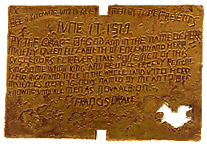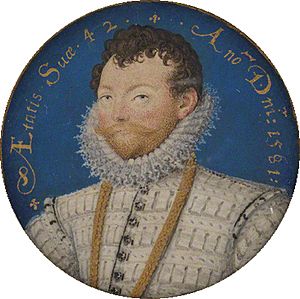Drake's Plate of Brass facts for kids
The Drake's Plate of Brass is a famous fake! It was supposed to be a brass plaque that the explorer Francis Drake left behind in Northern California in 1579. This trick fooled many people for 40 years, even though some had doubts early on.
The plate became public in 1936. Soon, historians started asking questions about its words, spelling, and how it was made. At first, many thought the plate was real after an early study of its metal said it was genuine. But in the late 1970s, scientists proved it was a modern fake after many tests. The mystery continued until 2003, when historians shared a theory about who made the plate and why. It turned out to be a practical joke that went wrong! Today, the plate is kept and often shown at the Bancroft Library at the University of California, Berkeley.
Contents
The Real Plate Drake Left Behind
In 1579, Sir Francis Drake landed somewhere on the Northwest Coast, not exactly in California as often thought. A person with Drake, named Francis Fletcher, wrote about it. He said Drake left "a plate" as a "monument of our being there." This plate claimed the land for "her maiesties, and successors."
Fletcher's notes also said the real plate included the date of the landing. It had Drake's name and a picture of the queen on a sixpence coin underneath it. This detailed description of the real plate later became the guide for the fake one.
How the Fake Plate Looked
The fake plate that appeared in the 1930s looked a lot like the one described in history. It was made of brass, and its letters seemed to be carved into the metal. There was even a hole for a sixpence coin. The words on the plate matched what Fletcher had written:
- BEE IT KNOWNE VNTO ALL MEN BY THESE PRESENTS.
- IVNE.17.1579
- BY THE GRACE OF GOD AND IN THE NAME OF HERR
- MAIESTYQVEEN ELIZABETH OF ENGLAND AND HERR
- SVCCESSORS FOREVER, I TAKE POSSESSION OF THIS
- KINGDOME WHOSE KING AND PEOPLE FREELY RESIGNE
- THEIR RIGHT AND TITLE IN THE WHOLE LAND VNTO HERR
- MAIESTIEES KEEPEING. NOW NAMED BY ME AN TO BEE
- KNOWNE V(N) TO ALL MEN AS NOVA ALBION.
- G. FRANCIS DRAKE
- (Hole for sixpence)
Who Made the Hoax Plate?
For a long time, no one knew for sure where the plate came from. But historians now have a clearer idea. The plate was made in 1917 by Herbert Eugene Bolton, a history professor at the University of California at Berkeley. He had help from others in this plan.
Bolton created the plate to challenge the work of another archaeologist, Zelia Nuttall. She believed Drake was never in California waters. Bolton and his friends stopped Nuttall from publishing her work. They waited until 1936 to "launch" the plate. By then, another historian, Eva Taylor, had found even more proof that Drake was further north.
When the fake plate was "found" on a hillside near San Francisco Bay, it seemed to prove Drake was in California. This amazing discovery was promoted by Herbert E. Bolton. It stopped any further discussion of Nuttall and Taylor's evidence. The plate was only declared a fake in 1977. By then, the idea of Drake being in California was firmly set in people's minds.
Some people said the plate was just a joke on Bolton that got out of hand. But it seems more likely that the hoax was planned to stop the idea of Drake landing on the Northwest Coast. The people involved might also have wanted to impress the public with historical items. They hoped to gain fame, attract students, and get money for their universities.
However, a well-known historian like Bolton risked his reputation if his tricks were found out. The plate became a strong symbol for California. It also supported the idea of Manifest Destiny, which was the belief that the English were meant to settle North America.
The "E Clampus Vitus" Group
According to a 2002 report, the plate was meant to be a joke among friends. These friends were part of a fun group of California history fans called E Clampus Vitus ("ECV"). This group started during the 1849 California Gold Rush. It was brought back in the 1930s by Carl Wheat, George Ezra Dane, and Leon Whitsell. They were historians and fans of Western stories. The ECV group said they were "dedicated to the erection of historical plaques, the protection of widows and orphans, especially the widows, and having a grand time while accomplishing these purposes." Playing pranks on fellow members was a regular part of their activities.
George Ezra Dane, a leader of ECV, was thought to have started the hoax. The joke was meant for his friend and fellow "Clamper," Herbert Bolton. The plate was probably made by George Clark in his workshop in 1917, following Bolton's design.
Herbert Eugene Bolton was the target of the hoax. He was a respected professor of California history and led the Bancroft Library at the University of California. For years, he told his students to look for the plate. He asked them to contact him if they ever found anything matching the historical description.
The 2002 report said that Dane started the plan. George Haviland Barron, a former museum curator, designed the plate. He bought the brass from a shipyard. A worker cut the plate from modern brass using a modern machine. George Clark, an inventor, hammered the letters into the plate with a simple chisel. Clark told his wife that the "C.G." before Drake's name was his own signature. As a final joke, Lorenz Noll and Albert Dressler painted "ECV" on the back of the plate. This paint could only be seen under ultraviolet light.
How the Plate Was "Found"
The people who planned the hoax likely placed the plate in Marin in 1933. This was near where Drake was thought to have landed. William Caldeira, a chauffeur, found the plate. He was with his boss, Leon Bocqueraz, who was hunting near Drakes Bay. Bocqueraz was a banker, and his friend, Anson Stiles Blake, was a well-known Berkeley graduate. Both were members of the California Historical Society.
Caldeira showed the dirty plate to Bocqueraz. He then put it in the car to check later, but he forgot about it. Weeks later, he found it while cleaning the car on the San Rafael Ferry. He threw it away on the side of the road in San Rafael, California. This was several miles from where it was first found. This was the first event that made the joke get out of the planners' control.
Re-discovery and Publicity
The plate was found again three years later, in 1936, by Beryle Shinn, a shop clerk. Shinn showed it to a friend, a Berkeley student. The student told him to take the plate to Herbert Eugene Bolton. In February 1937, Shinn brought it to Bolton. For Bolton, this was a dream come true after decades of searching. Bolton compared it to Francis Pretty's description of the real plate. He told the University of California president, Robert Gordon Sproul, and the California Historical Society president, Allen L. Chickering, about the possible major find. Chickering and Bolton agreed to buy the plate for $2,500 (which would be about $55,000 today). They also agreed to take all risks about whether the plate was real.
Then, more things happened that made the hoax even bigger. One day after agreeing to sell the plate, Shinn took it back from Bolton. He said he wanted to show it to his uncle and then return it. Bolton and Chickering did not hear from Shinn for four days. Fearing they might lose this big chance, Chickering quickly bought the plate for $3,500 (about $77,000 today). The plate was then given to the University's Bancroft Library.
Bolton soon announced at a California Historical Society meeting on April 6, 1937: "One of the world's long-lost historical treasures apparently has been found!" He added, "The authenticity of the tablet seems to me beyond all reasonable doubt." Bolton and Chickering had barely checked the plate. But they had now publicly committed themselves and their institutions to the plate being real.
When Doubts Started
Some people were doubtful and pointed out many suspicious things about the plate. Reginald B. Haselden, an expert in old English writings, wrote about the plate in September 1937. He listed many problems. The spelling seemed too modern. The words did not match how people spoke in the 1500s. For example, it said "Queen Elizabeth" instead of the usual "Elizabeth, by the Grace of God, Queen of England, France and Ireland, Defender of the Faith." The plate used modern words like "the" and "this" instead of the 16th-century "ye" and "y(i)s." Also, the plate looked too smooth, and its old-looking surface (patina) seemed fake.
However, none of these points alone seemed to prove it was fake. There were other ways to explain each issue. Haselden's points were immediately argued against. Chickering published a defense of the plate in the same magazine.
Scientists Prove It's a Fake
In the early 1970s, science finally caught up to Haselden's original doubts. Professor James D. Hart, who led the Bancroft Library, planned new tests. These were for the 400th anniversary of Drake's landing. He asked the Research Laboratory for Archaeology at Oxford University and the Lawrence Berkeley National Laboratory for a detailed study.
The tests included x-ray diffraction, stereo microscopy, and more metal analysis. X-ray diffraction and gamma-ray absorption tests showed the plate was too smooth. It was made by modern rolling machines, not hammered flat by hand in the 1500s. Frank Asaro, a scientist at Lawrence Berkeley Laboratory, used a special test called neutron activation analysis. He found the plate had too much zinc and too few impurities to be real English brass from Drake's time. It also had tiny amounts of metals found in modern American brass. Cyril Stanley Smith from MIT looked at the plate under a microscope. He saw that its edges were cut by modern equipment.
Images for kids
See also
 In Spanish: Placa de latón de Drake para niños
In Spanish: Placa de latón de Drake para niños





